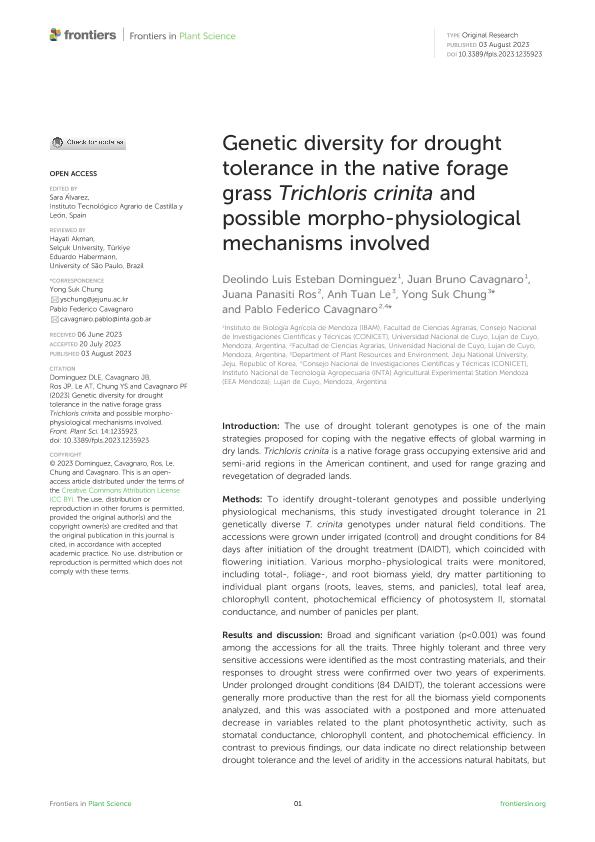Mostrar el registro sencillo del ítem
dc.contributor.author
Dominguez, Deolindo Luis Esteban

dc.contributor.author
Cavagnaro, Juan Bruno

dc.contributor.author
Panasiti Ros, J.
dc.contributor.author
Le, A. T.
dc.contributor.author
Chung, Y. S.
dc.contributor.author
Cavagnaro, Pablo Federico

dc.date.available
2024-01-04T14:02:59Z
dc.date.issued
2023-08
dc.identifier.citation
Dominguez, Deolindo Luis Esteban; Cavagnaro, Juan Bruno; Panasiti Ros, J.; Le, A. T.; Chung, Y. S.; et al.; Genetic diversity for drought tolerance in the native forage grass Trichloris crinita and possible morpho-physiological mechanisms involved; Frontiers Media; Frontiers in Plant Science; 14; 8-2023; 1-24
dc.identifier.uri
http://hdl.handle.net/11336/222394
dc.description.abstract
The use of drought tolerant genotypes is one of the main strategies proposed for coping with the negative effects of global warming in dry lands. Trichloris crinita is a native forage grass occupying extensive arid and semi-arid regions in the American continent, and used for range grazing and revegetation of degraded lands. To identify drought-tolerant genotypes and possible underlying physiological mechanisms, this study investigated drought tolerance in 21 genetically diverse T. crinita genotypes under natural field conditions.. The accessions were grown under irrigated (control) and drought conditions for 84 days after initiation of the drought treatment (DAIDT), which coincided with flowering initiation. Various morpho-physiological traits were monitored, including total-, foliage-, and root biomass yield, dry matter partitioning to individual plant organs (roots, leaves, stems, and panicles), total leaf area, chlorophyll content, photochemical efficiency of photosystem II, stomatal conductance, and number of panicles per plant. Broad and significant variation (p<0.001) was found among the accessions for all the traits. Three highly tolerant and three very sensitive accessions were identified as the most contrasting materials, and their responses to drought stress were confirmed over two years of experiments. Under prolonged drought conditions (84 DAIDT), the tolerant accessions were generally more productive than the rest for all the biomass yield components analyzed, and this was associated with a postponed and more attenuated decrease in variables related to the plant photosynthetic activity, such as stomatal conductance, chlorophyll content, and photochemical efficiency. In contrast to previous findings, our data indicate no direct relationship between drought tolerance and the level of aridity in the accessions natural habitats, but rather suggest genetic heterogeneity and ample variation for drought tolerance in T. crinita natural populations derived from a particular location or environment. Also, having low total and forageable biomass yield, or increased biomass allocation to the roots (i.e., lower foliage/root ratio), under optimal water availability, were not associated with greater drought tolerance. The drought-tolerant accessions identified are of value for future genetic research and breeding programs, and as forage for range grazing and revegetation in arid regions.
dc.format
application/pdf
dc.language.iso
eng
dc.publisher
Frontiers Media

dc.rights
info:eu-repo/semantics/openAccess
dc.rights.uri
https://creativecommons.org/licenses/by-nc-sa/2.5/ar/
dc.subject
LEPTOCHLOA CRINITA
dc.subject
DROUGHT STRESS
dc.subject
PHOTOASSIMILATES PARTITIONING
dc.subject
BIOMASS
dc.subject
STOMATAL CONDUCTANCE
dc.subject
PHOTOCHEMICAL EFFICIENCY
dc.subject.classification
Agricultura

dc.subject.classification
Agricultura, Silvicultura y Pesca

dc.subject.classification
CIENCIAS AGRÍCOLAS

dc.title
Genetic diversity for drought tolerance in the native forage grass Trichloris crinita and possible morpho-physiological mechanisms involved
dc.type
info:eu-repo/semantics/article
dc.type
info:ar-repo/semantics/artículo
dc.type
info:eu-repo/semantics/publishedVersion
dc.date.updated
2024-01-03T12:27:12Z
dc.identifier.eissn
1664-462X
dc.journal.volume
14
dc.journal.pagination
1-24
dc.journal.pais
Suiza

dc.journal.ciudad
Lausanne
dc.description.fil
Fil: Dominguez, Deolindo Luis Esteban. Consejo Nacional de Investigaciones Científicas y Técnicas. Centro Científico Tecnológico Conicet - Mendoza. Instituto de Biología Agrícola de Mendoza. Universidad Nacional de Cuyo. Facultad de Ciencias Agrarias. Instituto de Biología Agrícola de Mendoza; Argentina
dc.description.fil
Fil: Cavagnaro, Juan Bruno. Consejo Nacional de Investigaciones Científicas y Técnicas. Centro Científico Tecnológico Conicet - Mendoza. Instituto de Biología Agrícola de Mendoza. Universidad Nacional de Cuyo. Facultad de Ciencias Agrarias. Instituto de Biología Agrícola de Mendoza; Argentina
dc.description.fil
Fil: Panasiti Ros, J.. Universidad Nacional de Cuyo. Facultad de Ciencias Agrarias. Departamento de Ciencias Biológicas. Cátedra de Fisiología Vegetal; Argentina
dc.description.fil
Fil: Le, A. T.. Jeju National University; Corea del Sur
dc.description.fil
Fil: Chung, Y. S.. Jeju National University; Corea del Sur
dc.description.fil
Fil: Cavagnaro, Pablo Federico. Instituto Nacional de Tecnología Agropecuaria. Centro Regional Mendoza-San Juan. Estación Experimental Agropecuaria Mendoza; Argentina. Consejo Nacional de Investigaciones Científicas y Técnicas. Centro Científico Tecnológico Conicet - Mendoza; Argentina
dc.journal.title
Frontiers in Plant Science
dc.relation.alternativeid
info:eu-repo/semantics/altIdentifier/doi/http://dx.doi.org/10.3389/fpls.2023.1235923
dc.relation.alternativeid
info:eu-repo/semantics/altIdentifier/url/https://www.frontiersin.org/articles/10.3389/fpls.2023.1235923/full
Archivos asociados
